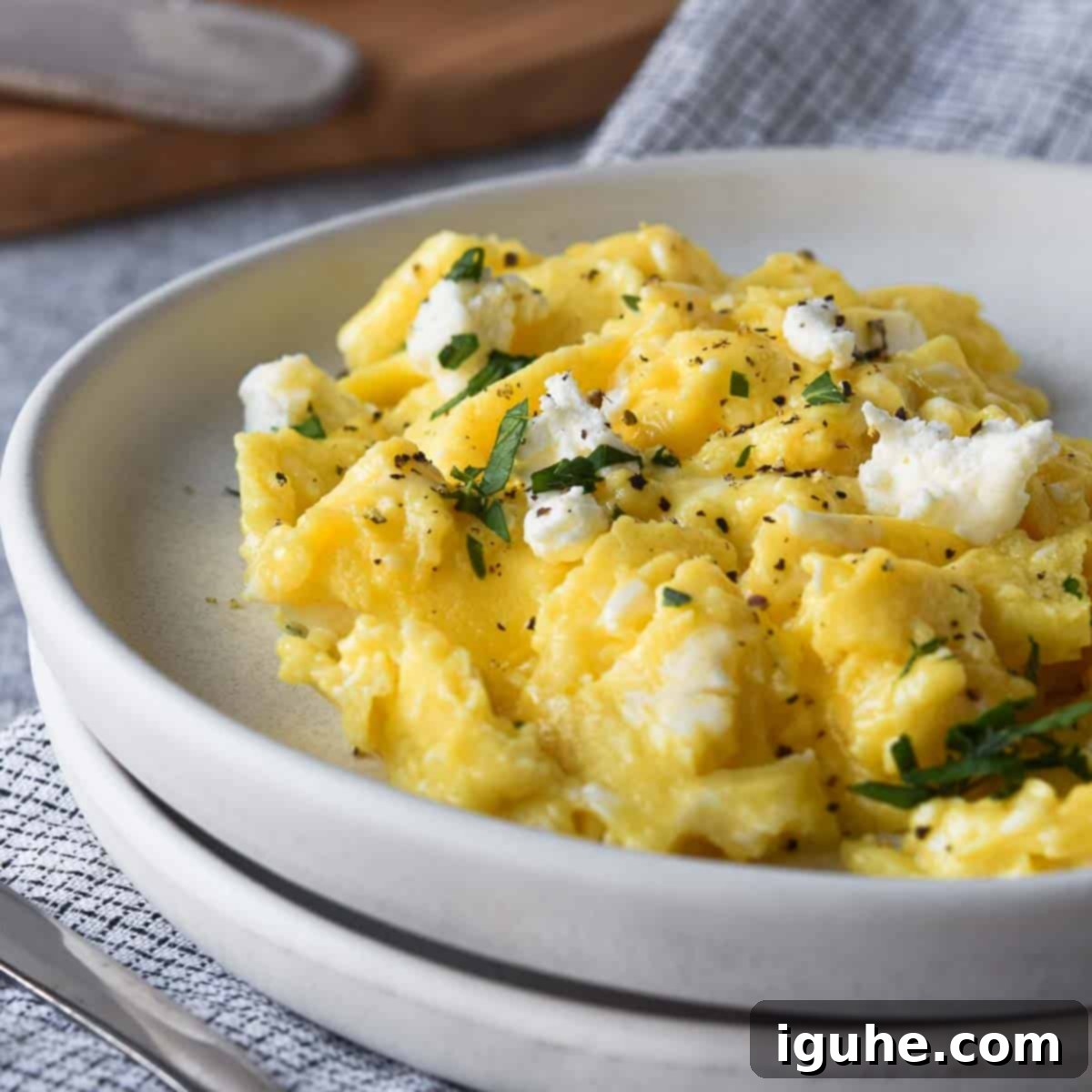Elevate Your Breakfast: Master the Art of Creamy Goat Cheese Scrambled Eggs (Chèvre Eggs)
Are you tired of bland, uninspiring scrambled eggs? It’s time to revolutionize your breakfast with these incredibly creamy and flavorful Goat Cheese Scrambled Eggs, also affectionately known as chèvre eggs. Forget dry, rubbery results; this recipe promises soft, fluffy eggs infused with a delightful tangy richness that will redefine your morning meal. Seasoned simply with fresh herbs, salt, and pepper, you’ll be astonished by how easy it is to achieve such a gourmet experience right in your own kitchen.
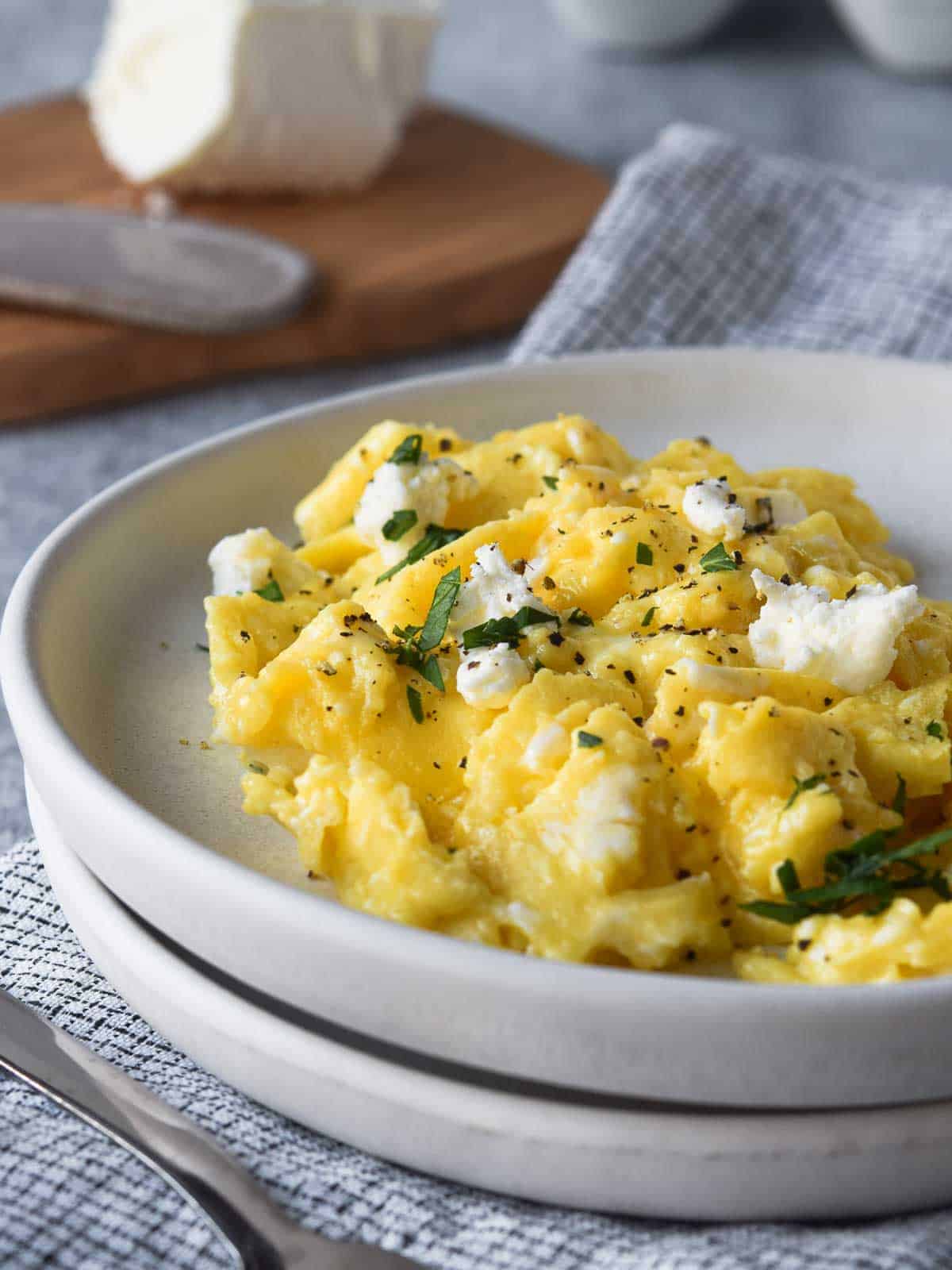
Scrambled eggs are a beloved breakfast classic, and everyone has their preferred style. Whether you enjoy them well-done or crave that soft, creamy texture (like me), there’s always room for an upgrade. Adding goat cheese to your scrambled eggs is perhaps the simplest yet most sophisticated culinary decision you’ll make today. This recipe promises a transformative experience, making it hard to go back to your old ways. Once you savor the unique creaminess and subtle tang, you’ll understand why.
Why Goat Cheese is Your Scrambled Egg Game Changer
Goat cheese brings an unparalleled level of flavor and texture to scrambled eggs. Unlike many other cheeses that can become stringy or oily when heated, goat cheese melts into a smooth, velvety consistency, creating incredibly tender curds. Its natural tanginess provides a wonderful counterpoint to the richness of the eggs, waking up your taste buds and adding a gourmet touch without any extra effort. The moment the goat cheese is added, just as the eggs finish cooking, it gently incorporates, resulting in a perfectly creamy, melt-in-your-mouth experience that is a world away from dry, rubbery eggs.
[feast_advanced_jump_to]What is the Difference Between Goat Cheese and Chèvre?
“Chèvre” and “goat cheese” are terms often used interchangeably, and while they broadly refer to cheese made from goat’s milk, there are some subtle distinctions. “Goat cheese” is the overarching English term for any cheese derived from goat’s milk, which can encompass a vast array of types, from fresh and soft to aged and hard. “Chèvre,” on the other hand, is a French term that literally means “goat” but specifically refers to cheese made from goat’s milk, often implying the fresh, soft, and tangy varieties that are most commonly used in dishes like these scrambled eggs. In essence, all chèvre is goat cheese, but not all goat cheese is chèvre, particularly when considering aged or firm varieties.
What Does Goat Cheese Taste Like?
Goat cheese possesses a distinctive flavor profile that sets it apart from cheeses made from cow’s milk. Its taste is influenced by factors such as the region of production, the goat’s diet, and the specific methods used during cheesemaking. Generally, fresh goat cheese or chèvre, like the kind recommended for these scrambled eggs, offers a mild, creamy, and slightly tart flavor with a clean, crisp finish. It can range from bright and lemony to earthy and grassy, depending on its age and how it’s prepared. Because of its inherent creaminess, goat cheese melts beautifully, making it an excellent addition to warm dishes. Its versatility allows it to pair wonderfully with salads, pizzas, and pasta, and it’s a staple on any sophisticated cheese board. You might also encounter it fried, whipped into spreads, crumbled over various dishes, or infused with different flavors like herbs or honey.
Ingredients for Perfect Chèvre Eggs
Crafting these creamy goat cheese scrambled eggs requires just a few simple, high-quality ingredients. Each component plays a crucial role in achieving that desirable soft, flavorful texture.
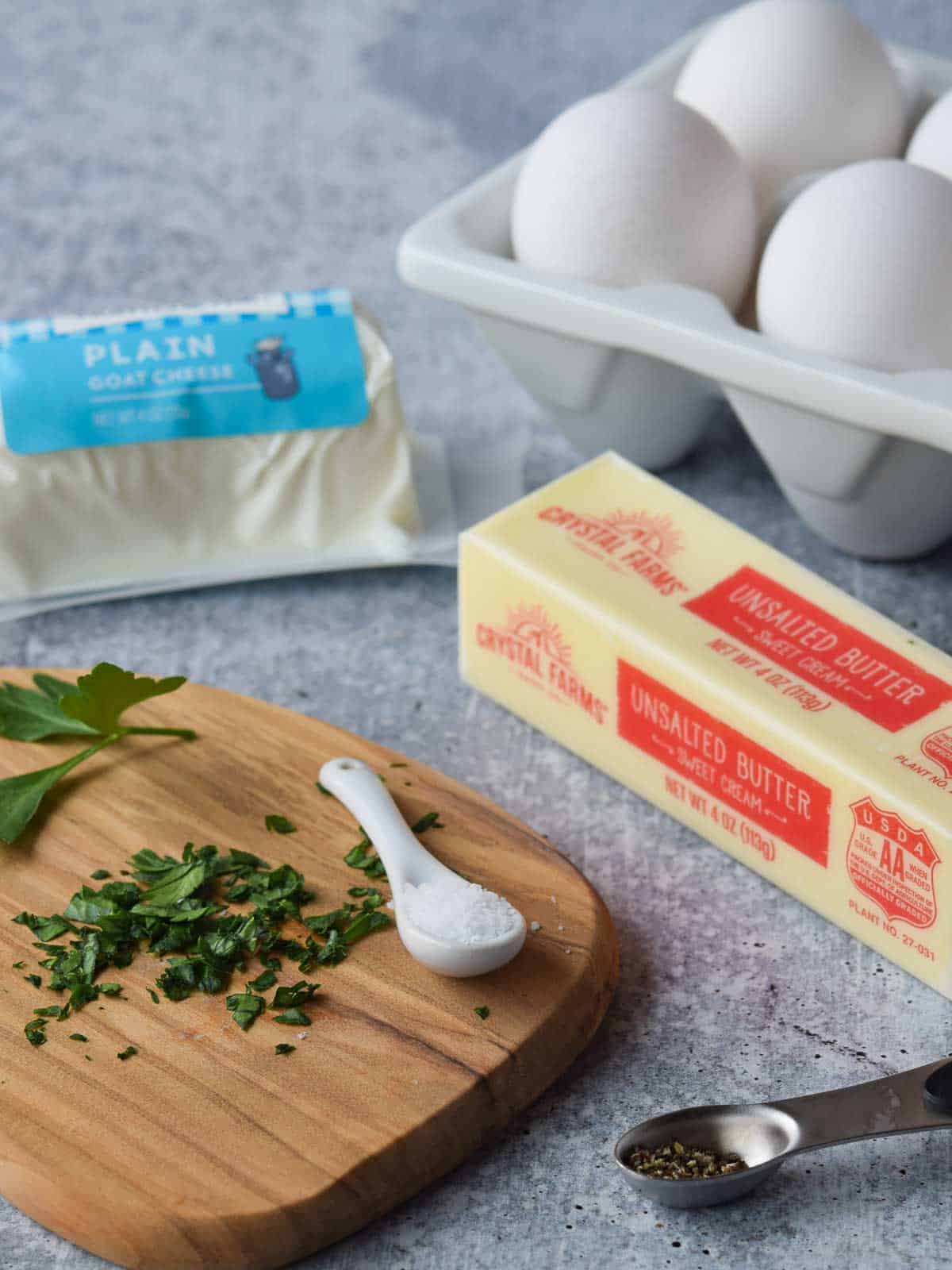
- Eggs – I always opt for large eggs for consistent results and a good volume for scrambling. Fresh, good-quality eggs make a noticeable difference in flavor and texture.
- Goat cheese or chèvre – The star of the show! For the best creamy texture, look for goat cheese sold in a log form. These varieties are typically much creamier and melt more smoothly than pre-crumbled goat cheese, which can sometimes be drier.
- Fresh herbs – A sprinkle of fresh herbs adds a vibrant burst of flavor and a beautiful aroma. Excellent choices include chives for a delicate oniony note, parsley for freshness, chervil for a subtle anise flavor, tarragon for a hint of licorice, or dill for a bright, slightly tangy touch.
- Butter – Essential for cooking the eggs and contributing to their rich, velvety texture. I prefer unsalted butter, as it allows me to control the seasoning precisely without adding excess salt from the butter itself.
- Salt and pepper – Simple seasonings are all you need. Kosher or fine sea salt enhances the natural flavor of the eggs, and freshly ground black pepper adds a gentle warmth.
Essential Equipment for Fluffy Scrambled Eggs
To ensure your goat cheese scrambled eggs turn out perfectly, a couple of key pieces of equipment are essential. Investing in these will make the cooking process smoother and the clean-up a breeze:
- Non-stick skillet or pan: This is crucial for preventing the eggs from sticking and ensuring they cook evenly without tearing. There’s nothing worse than stubborn, sticky eggs to clean up! A good non-stick surface allows you to gently move and fold the eggs as they cook.
- Silicone spatula: A flexible silicone spatula is your best friend when making scrambled eggs. Its soft edges won’t scratch your non-stick pan, and its pliability allows you to effectively scrape the bottom and sides of the pan, helping to create those desirable soft curds.
How to Make Scrambled Eggs with Goat Cheese: A Visual Guide
Follow this easy visual guide to master the technique for making perfect creamy goat cheese eggs. Detailed instructions are available in the recipe card below.

In a small bowl, crack your eggs and add the salt. Whisk vigorously with a fork or whisk until no visible egg whites remain and the mixture is uniformly yellow and slightly frothy. Proper whisking ensures a consistent texture.
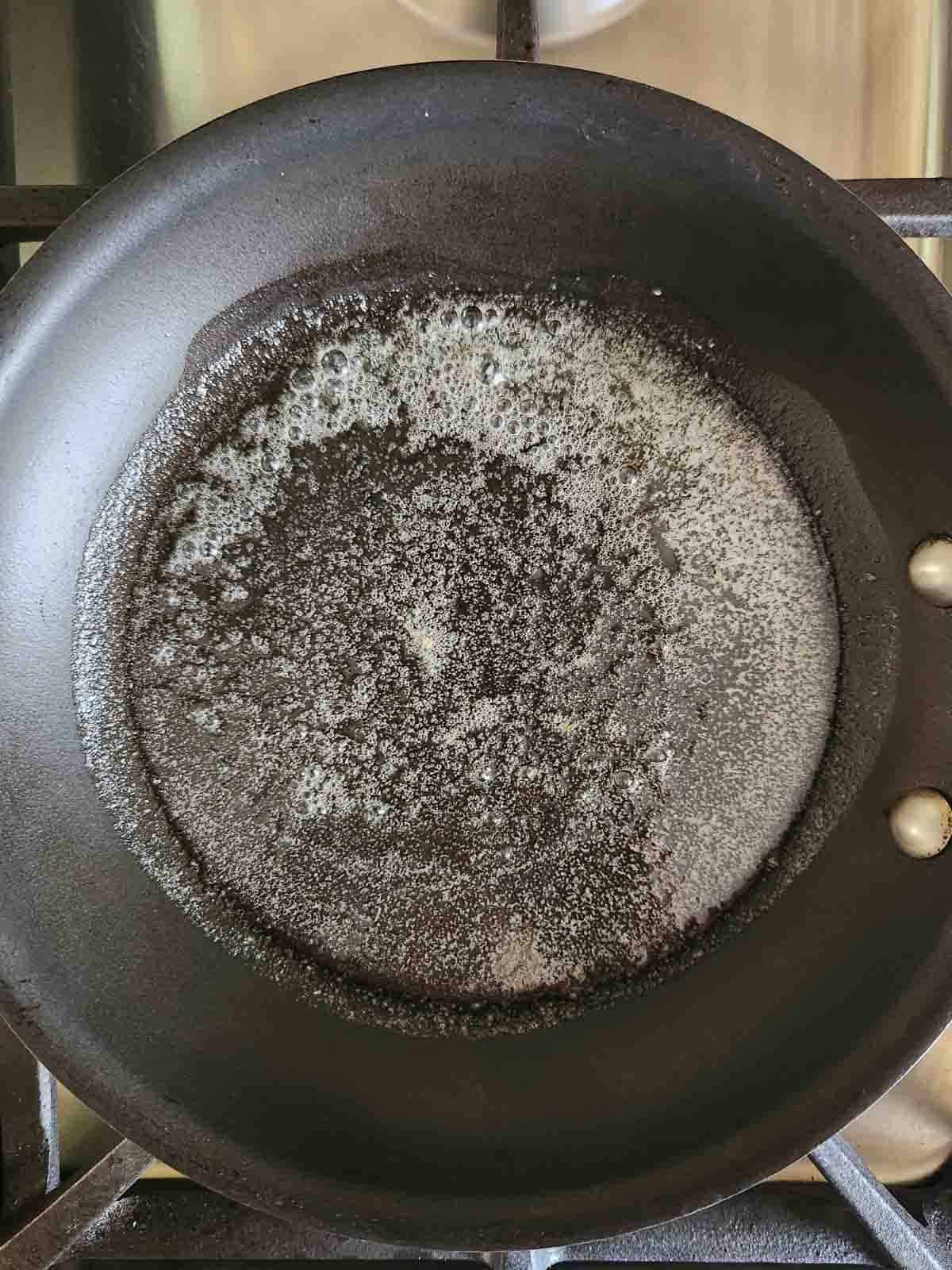
Place a small non-stick skillet over medium-low heat. Add the butter and let it melt until it becomes foamy. The foam indicates that the water in the butter is evaporating, leaving behind pure butterfat, which is ideal for cooking eggs without burning them.
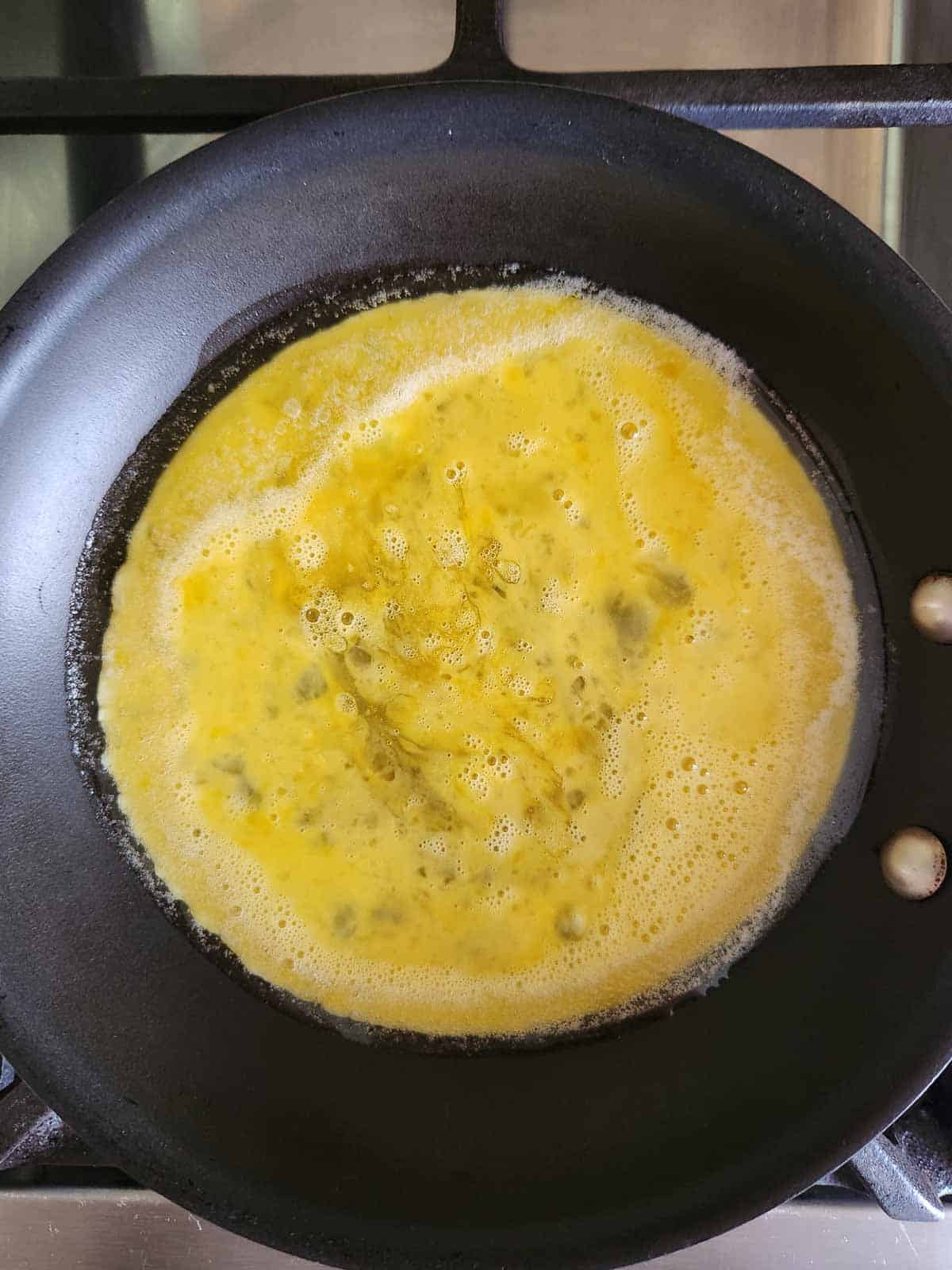
Once the butter is foamy, pour the whisked eggs directly into the skillet. The low heat will allow for a slow, gentle cook, which is key to creamy scrambled eggs.
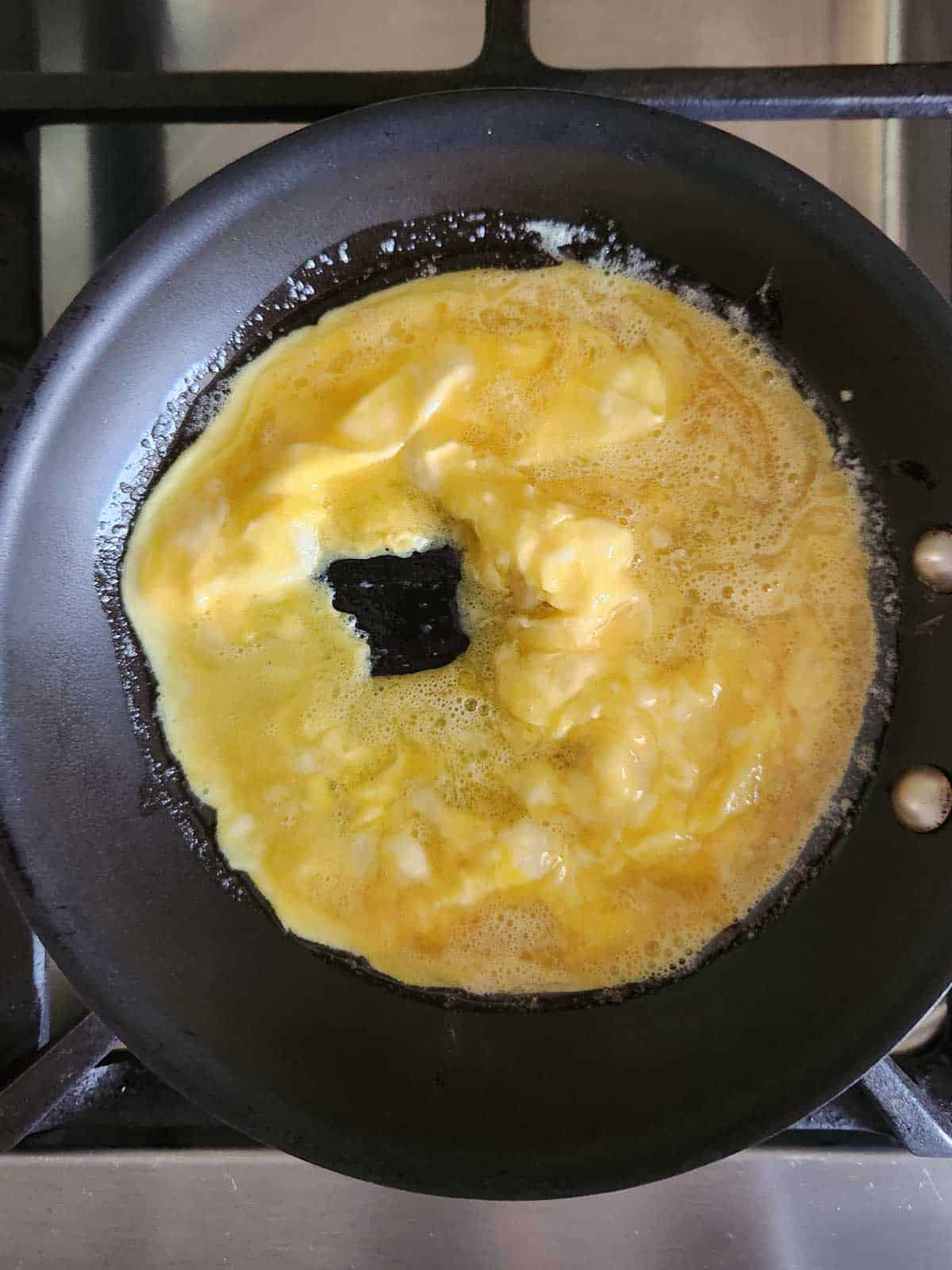
Using your silicone spatula, gently push the eggs back and forth across the pan. This motion helps to create soft, tender curds. If you notice the eggs cooking too quickly, don’t hesitate to reduce the heat to low to maintain control.

Continue to gently slide and fold the eggs from side to side. The goal is a slow, even cook that results in soft, moist curds, not dry, firm pieces. Be patient and keep an eye on their consistency.
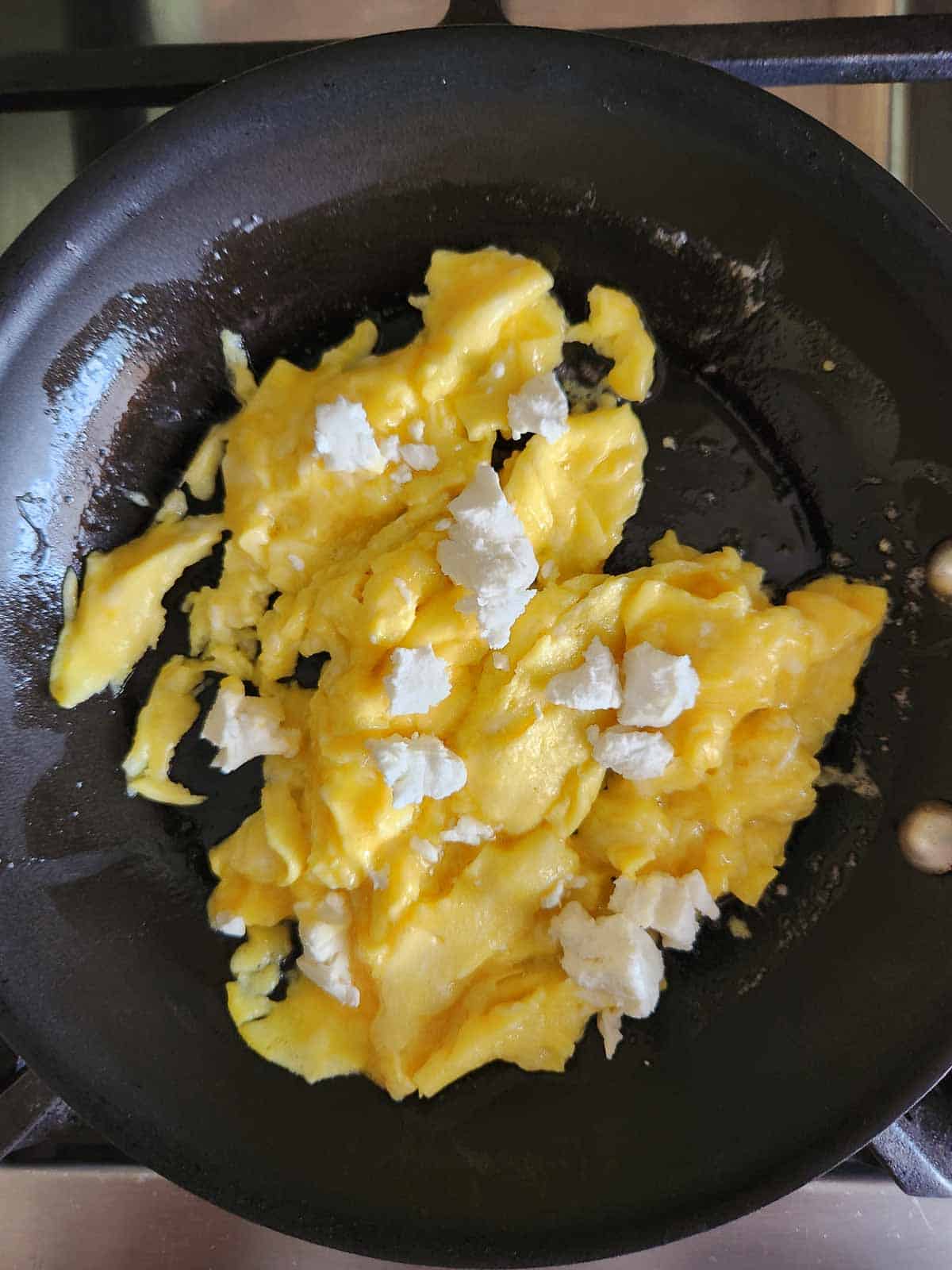
When the eggs are almost set – meaning they still have a slight wetness or a few traces of liquid – crumble the goat cheese directly onto them. Stir gently until the cheese begins to melt and is incorporated, then immediately remove the pan from the heat. The residual heat will continue to cook the eggs to perfection, ensuring they remain incredibly soft and creamy.
Season with additional salt, freshly ground pepper, and your chosen fresh herbs before serving for an extra pop of flavor and visual appeal.
📝Expert Tips for Achieving the Best Scrambled Eggs with Goat Cheese
- Keep the heat low or medium-low. High heat is the enemy of creamy scrambled eggs. It will cook the eggs too quickly, causing them to dry out and become rubbery. A gentler heat allows the curds to form slowly and evenly, retaining moisture for that coveted soft texture. Patience is key here!
- Don’t walk away from your pan once the eggs are added. Scrambled eggs cook surprisingly fast, especially in a hot pan. Staying attentive ensures you can monitor the cooking process and remove them from the heat at the precise moment they reach perfection, preventing overcooking.
- Use a silicone spatula for best results. A flexible silicone spatula allows you to gently scrape the bottom and sides of your non-stick pan without damaging it. Stir often and slowly, moving the spatula across the pan in various directions. This technique helps to form uniform curds. For smaller, finer curds, stir more frequently and use the spatula to gently break up the eggs. For larger, fluffier curds, use longer, less frequent strokes.
- Once the eggs are mostly cooked, but still have a few traces of liquid, add the cheese. Then turn off the heat. This is a critical step for maximum creaminess. Adding the goat cheese when the eggs are still slightly wet allows it to melt smoothly and integrate perfectly into the eggs without overcooking them. The residual heat from the pan will continue to gently cook the eggs and melt the cheese to a luscious consistency.
- Season eggs after removing them from heat. Adding salt too early can sometimes toughen eggs. Seasoning at the end ensures the best flavor and helps maintain their delicate texture. Freshly ground pepper and herbs should also be added at this stage for optimal taste and aroma.
Delicious Serving Suggestions for Your Goat Cheese Scrambled Eggs
These flavorful goat cheese scrambled eggs are wonderful on their own, but they also pair beautifully with a variety of sides to create a complete and satisfying meal. Here are some of my favorite ways to enjoy them:
- Classic Toast: You can’t go wrong with a side of perfectly buttered toast or even a slice of artisan bread. For an extra special treat, try it with whipped strawberry basil butter for a sweet and savory contrast.
- Fresh Fruit: Brighten your plate and add a refreshing contrast with a cup of your favorite seasonal fresh fruit. Berries, sliced melon, or citrus segments complement the richness of the eggs beautifully.
- Crispy Bacon or Sausage: For a hearty breakfast, serve your chèvre eggs alongside delicious candied bacon or your preferred breakfast sausage. It’s a classic combination for a reason!
- Light Salad: To keep things feeling fresh and balanced, pair your scrambled eggs with a simple side salad. A light green salad with a vinaigrette or a vibrant fruit and cheese salad like this peach burrata salad offers a delightful textural and flavor counterpoint.
- Avocado Toast: Elevate your entire breakfast by serving your goat cheese scrambled eggs on top of creamy avocado toast. The healthy fats and earthy flavors of avocado create a harmonious pairing with the tangy chèvre.
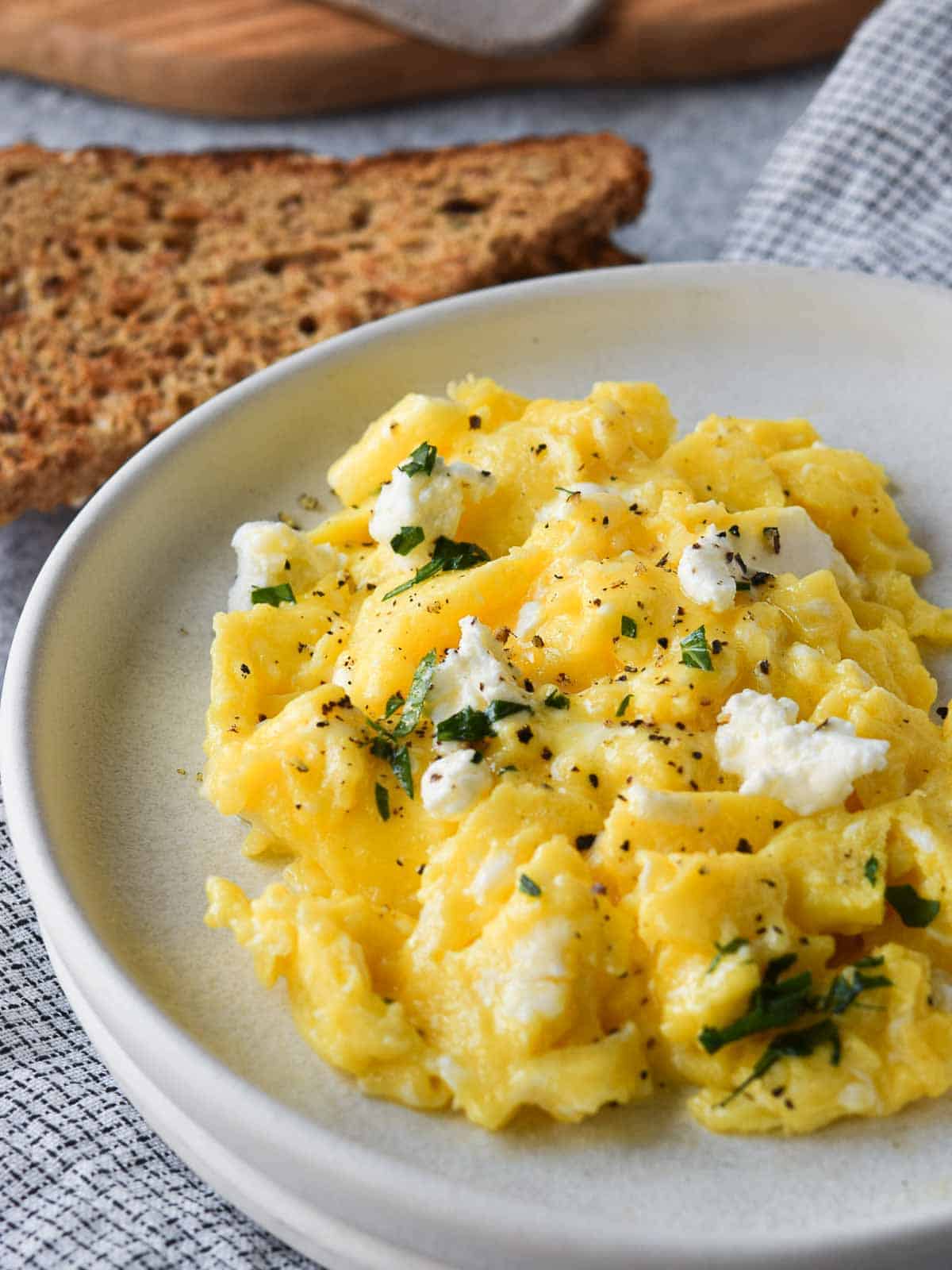
Storage and Reheating Tips
Scrambled eggs, especially creamy ones like these goat cheese eggs, are always best enjoyed immediately after cooking. Their delicate texture and fresh flavors are at their peak. However, if you find yourself with leftovers, you can certainly store them for a quick future meal. Place any remaining scrambled eggs in an airtight container and refrigerate for up to 3 days.
To reheat, you have a couple of options: gently microwave the eggs in 20-30 second intervals, stirring in between, until heated through. Be careful not to overcook them in the microwave, as this can make them tough. Alternatively, you can gently reheat them in a non-stick pan over low heat on the stove, stirring occasionally, adding a tiny splash of milk or water if they seem a bit dry to help restore some moisture.
Frequently Asked Questions About Goat Cheese Scrambled Eggs
Adding milk or cream to scrambled eggs is an optional practice often believed to enhance moisture and create a creamier texture. However, with this goat cheese scrambled eggs recipe, the rich and creamy nature of the goat cheese itself largely eliminates the need for additional dairy liquids. The goat cheese melts into the eggs, providing ample moisture and a luxurious texture without the need for milk or cream. If you prefer, you can add a tablespoon for extra richness, but it’s not essential for a delicious outcome.
While a log of fresh goat cheese is recommended for its superior creaminess and melting ability, you can certainly use pre-crumbled goat cheese if that’s what you have on hand. Just be aware that crumbled goat cheese might not melt as smoothly or integrate as seamlessly into the eggs, sometimes leading to small, distinct pieces rather than a uniform creamy texture. It will still impart its delicious tangy flavor, so don’t hesitate to use it!
These goat cheese scrambled eggs are fantastic as is, but they also serve as an excellent base for various additions. Consider sautéed spinach or mushrooms for added vegetables, sun-dried tomatoes for a burst of umami, or a touch of red pepper flakes for a subtle kick. Cooked chopped bacon or ham can also be stirred in for extra protein and flavor. Just be mindful of not overcrowding the pan to ensure proper cooking.
Egg-cellent Pairings: More Breakfast & Brunch Ideas
Looking for other delightful dishes to complement your creamy scrambled eggs or expand your breakfast repertoire? These recipes offer fantastic flavors and textures that pair perfectly with a serving of goat cheese scrambled eggs, or stand strong on their own.
- Orange and Cardamom French Toast
- Maple Raisin Overnight Oats
- Blueberry Skillet Pancake
- Smoked Gouda and Chive Scones
Did you make this recipe? I would love to hear about it! Please leave a ⭐⭐⭐⭐⭐ rating with a comment right below the recipe card. If you snap a photo of your creation, don’t forget to tag me on Instagram @brunchandbatter.
📖Recipe
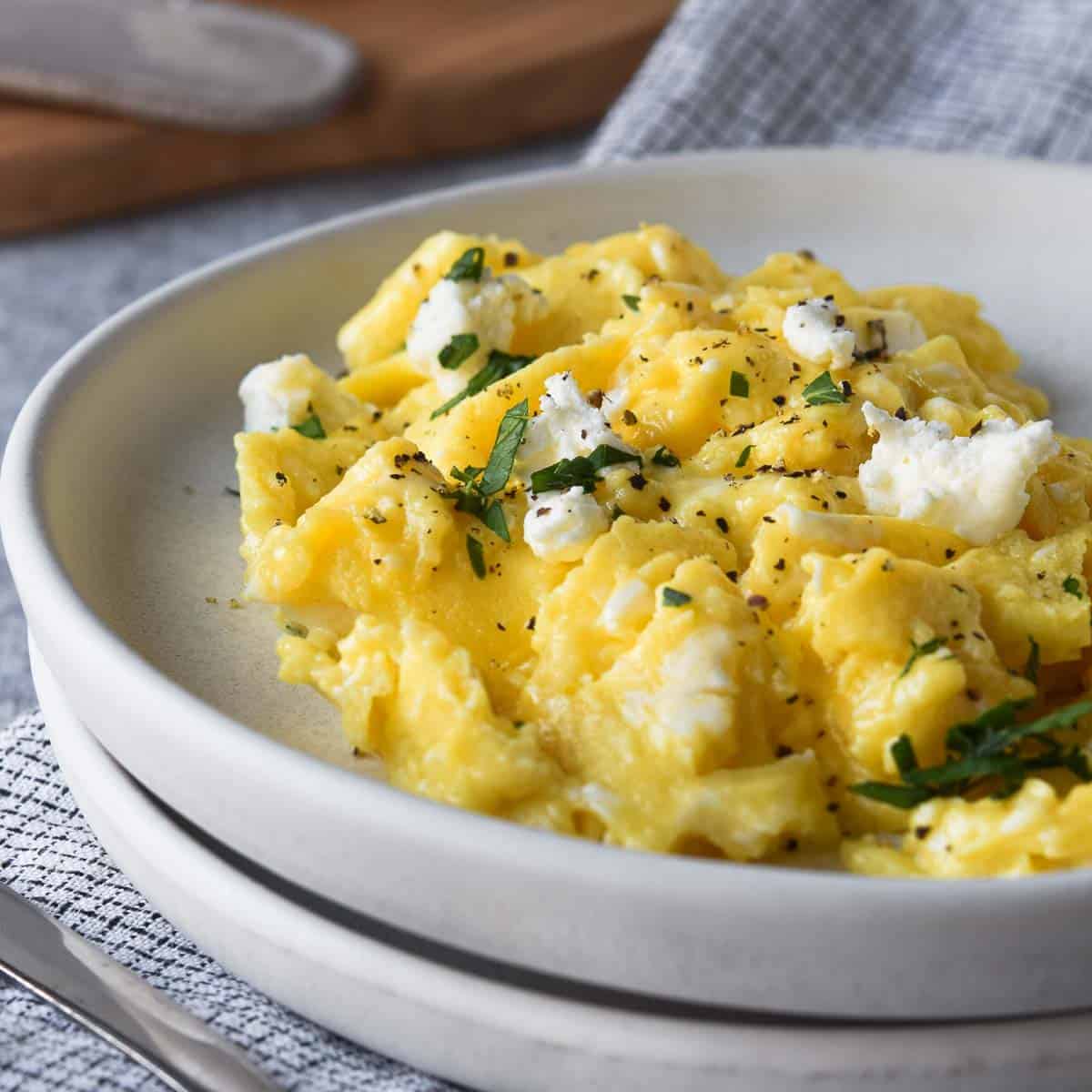
Goat Cheese Scrambled Eggs
Equipment
-
non stick pan or griddle
-
silicone spatula
Ingredients
- 2 large eggs
- 2 tablespoon goat cheese (log version)
- ¼ teaspoon Kosher or fine sea salt
- ⅛ teaspoon fresh ground pepper
- 1 tablespoon butter
- 1-2 teaspoon fresh chopped herbs such as chives, parsley, or tarragon
Instructions
-
In a small bowl, whisk the eggs and salt vigorously until no egg whites remain. Ensure the mixture is well combined and slightly frothy for the best texture.2 large eggs, ¼ teaspoon Kosher or fine sea salt
-
Heat a small non-stick skillet over medium-low heat. Add butter and cook until it starts to foam. The foaming indicates the butter is ready and helps prevent scorching.1 tablespoon butter
-
Pour the whisked eggs into the skillet. With a silicone spatula, gently push the eggs from side to side, across the pan, to start forming soft curds. Slowly, but continuously move the spatula in all directions, folding the eggs over themselves until they begin to set but still appear moist. If they cook too fast, immediately lower the heat to low. When the eggs are just about set, and a few traces of liquid remain, crumble in the goat cheese evenly over the eggs. Give it a final gentle stir to incorporate the melting cheese, then immediately remove the pan from the heat. The residual heat will finish the cooking process.2 tablespoon goat cheese (log version)
-
Season with fresh ground pepper and additional salt if needed, to taste. Sprinkle the fresh chopped herbs generously over the top for a vibrant finish. Serve your creamy goat cheese scrambled eggs immediately to enjoy them at their best!⅛ teaspoon fresh ground pepper, 1-2 teaspoon fresh chopped herbs such as chives, parsley, or tarragon
Notes
- Keep the heat to low or medium-low. Having the heat too high will scorch the eggs causing them to become dry and rubbery.
- Don’t walk away from your pan once the eggs are added. The cooking process will go quickly and you don’t want them overcooked.
- Use a silicone spatula for best results. Stir often and slowly, scraping the spatula across the pan, multiple times in all directions. This will help form the curds. Stir more often for small curds, using the spatula to break up the eggs. Create longer strokes with a spatula for larger curds.
- Once the eggs are mostly cooked, but still have a few traces of liquid, add the cheese. Then turn off the heat. The residual heat from the pan will continue to cook the eggs.
- Season eggs after removing them from heat.
Nutrition*
*Nutrition information is provided as a courtesy and is an estimate only. Nutrition information can vary depending on many factors, such as products used, measurements and substitutions, therefore it is recommended that you obtain nutritional calculations based on your own finished recipe.
